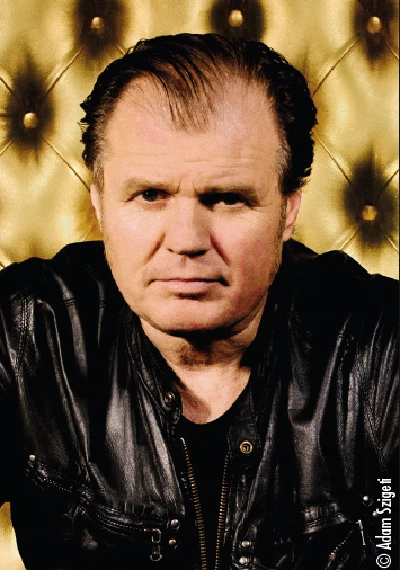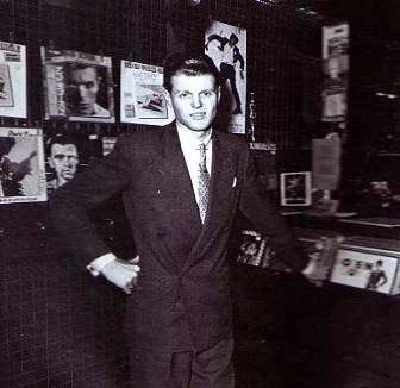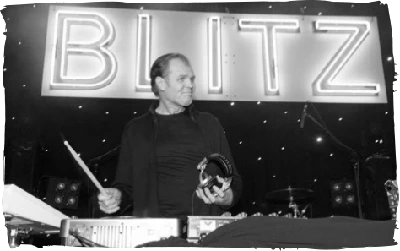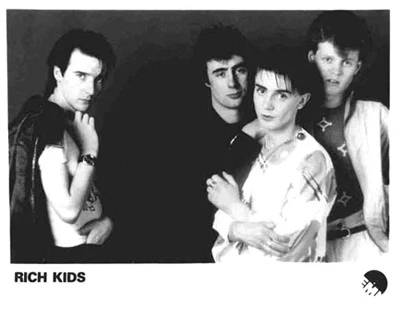published: 9 /
6 /
2021
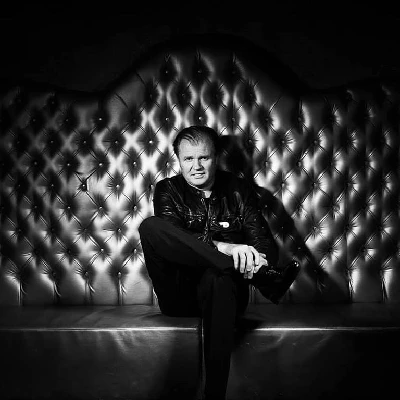
Blitz Club DJ and New Romantic pioneer Rusty Egan talks to Andrew Twambley about drumming with Rich Kids, his soundtrack to the new Sky documentary ‘Blitzed’ about The Blitz, his admiration of The Glitterband and how brought Madonna to the UK,
Article
Rusty Egan is perhaps best known as the musician behind Visage and their timeless single ‘Fade to Grey.’ But Rusty is far more than one part of a one hit wonder. Not only was he the drummer in Glen Matlock’s incandescent but ill-fated Rich Kids, but he then went on to introduce Krautrock into the nightclubs of this country, set up The Blitz and later The Camden Palace, and thus become responsible for the emergence and development of the New Romantic movement.
We spoke to Rusty about his soundtrack to the new Sky documentary ‘Blitzed’ about The Blitz, his admiration of The Glitterband and how he brought Madonna over to the UK.
PB: I want to talk to you about the album ‘Rusty Egan Presents Blitzed’, but rather than crashing straight into that I think we need to go way back and look at where the whole Blitz scene came from. I first ran into you at Eric’s Club in Liverpool on the 4th February 1978 as the fresh-faced drummer of ‘powerpop’ band Rich Kids. How did you team up with Glen Matlock, Midge Ure and Steve New?
RE: I spent the summer of ‘76 playing for The Clash while they were looking for a drummer, and that’s how I met Glen Matlock through Mick Jones. I didn’t really fit in with The Clash as I was a Roxy Music/Bowie/Kraftwerk guy. But I loved Bowie’s Berlin Trilogy and the Iggy Pop albums, ‘The Idiot’ and ‘Lust for Life’ .and they were welcomed in the punk world.
PB: So, from there onto the big question. You became responsible for creating the sound of the New Romantic movement in the early 1980s. How did you do that?
RE: There is no short answer to that, so we need to take a few steps back. You’ve got your favourite records and your favourite drummers and you’ve just got this sound in your head. You finally get into the recording studio as we did with Rich Kids with the mighty Mick Ronson, and you’re like “Yeah, we’re going to do this., and all you hear is, “Rusty, shut the fuck up and get to the back of the room. We’re producing the record and you’re the drummer. So play your drums!”
So, Rich Kids made this album ‘Ghosts of Princes in Towers’, which I really liked. I thought it was sort of futuristic. It wasn’t a total punk record, despite Glen’s obvious influence. It was more poppy with a taste of things to come. It had an anti-National Front, Anti-Nazi League theme to it. I thought it was really in the moment but the UK press didn’t take to it too well. By the time we released ‘Ghosts…’ we were already written off. Midge Ure and I had acquired a drum machine and Glen hated it. There was no way he was going to allow his band to become a synth band, so that was the end of Rich Kids.
I’d heard German music by then, ‘Krautrock’, as it became known, with artists such as Kraftwerk, Can, Tangerine Dream and La Dusseldorf. They were this big influence on me. Steve Strange had been following Rich Kids around the country and he had become a friend of mine. He took me to some amazing gay clubs. Although I was a straight man, I felt safer in the gay world than I did in the straight world. You go to a gay club and have a great night out. You meet loads and loads of people including girls and nobody wants to beat you up (Laughs). The worst possible thing is they want to take you home (Laughs). I loved it as I was so used to violence after the punk days. That fantastic music really took hold of me and launched me into The Blitz and DJing.
PB: Your latest album, ‘Rusty Egan Presents Blitzed’, goes along with the Sky Arts documentary of the same name. It runs to thirty-two songs and over three hours. What exactly is the album?
RE: Steve Strange and I started The Blitz and we played my music, music that hardly anyone knew really, such as the German stuff alongside Roxy Music, Magazine, Grace Jones, Iggy Pop and John Foxx. I had all these records and I was saying to Midge, “We need to make music like this” which we eventually did with Visage. At this point, Strange was on the door dragging all the cool kids in, and Boy George was in the cloakroom. He didn’t know any of that music, and he didn’t bloody care either. Marilyn was dancing around saying, “Rusty, stop playing all this bloody electronic stuff. I hate it. Why don’t you play reggae?”
So, when I got asked to do incidental music for the documentary about The Blitz Club, I thought “Yeah, let’s relive The Blitz and bring it into the 21st Century without losing any of the spirit of The Blitz.” I’m in lockdown and I can’t go out and DJ but I can make incidental music all day long. So I said, “What’s the scene?” and they said, “The scene is everyone going out for the night,” and I said, “Well, I’ve written a song called ‘When We Were Young’, played it to them and they loved it, so I edited it and made The Blitz club mix and it is the first track on the album. And the whole project went on from there. P
PB: Where did that particular song come from in the first place?
RE: It came from me and Paul Statham from B-Movie. I wanted to write with him. I signed him originally and I asked him when I was doing my solo album, “Have you got any music ideas?” and he sent me over that bass line, and I said, “Wow, it sounds like a Blitz Club record,” and then put a few synthesizers on it, put the drum beat to it and then I wrote the song.
That same type of sound is on the Tony Hadley track on the album, ‘The Lonely Highway’. In 2016, I put an album out called ‘Welcome to the Dancefloor’, and I had Tony Hadley, Peter Hook and Midge on that, so I thought I should put versions of those songs on the Blitz soundtrack.
I had a song on my album called ‘Ballet Dancer’, so I put the instrumental version on the Blitz album. It really needed ‘Heroes’ by David Bowie but they wouldn’t allow that, despite it being a Blitz anthem. I’ve been trying to do a true Blitz compilation album for about twenty-five years and I’ve never been able to get the clearance from the bastard record companies.
PB: When I saw Rich Kids at Eric’s in ‘78 you didn’t look like a punk, and at The Blitz you didn’t look like Steve Strange of Boy George either. In fact, you looked like me! How come you didn’t conform to the looks?
RE: I was going to all the top clubs in London such as Madame Jojo’s and The Roxy. I was never dressed like a high street kid. I was always a bit of a fashion soul boy, and when I was fourteen to fifteen I was a bit of a mod, suedehead. I went through all the normal youth fashions and I was into Roxy Music and David Bowie, so I was into what you would call gender neutral fashion. I loved all the make-up and diversity.
When I played in Rich Kids my clothes were the best that I could afford. I was living down the Kings Road and wearing clothes from market shops. I sweated through everything, with being a drummer, so had a vast array of clothes. I used to wear leather trousers but I couldn’t wear them on stage as it was too hot. I loved those pirate boots, and Glen Matlock had a load of clothes from his Pistols days, so I used to borrow them. I didn’t look like Steve Strange, Boy George or Marilyn. They were way ahead of their time. I looked like me! All of the Blitz kids had their own individual style. I was like the Bowie/Roxy Music kind of dresser.
PB: It is clear that you have a strong and close relationship with Midge Ure. How have you managed to maintain a relationship for so long in such a destructive industry?
RE: I have known Midge a long time and we have a mutual respect for each other. When Midge invited me on his tour, he treated me as an equal and gave me respect, a rare commodity in this industry. I think Midge is a great guy, They broke the mould when he was born.
PB: You are the only person I have ever interviewed who has acknowledged that The Glitterband were a great pop band. Are you not afraid of the connection to their ostracised former leader?
RE: Most people don’t know shit. Mike Leander, who created The Glitterband, was the genius there. Paul Gadd or whatever his name is (Gary Glitter) was the Steve Strange of the act right, and just a frontman. The music was written and performed by Gerry Shepherd and Mike Leander. They were the band but the bloody men in suits said they needed a frontman which is where Gary Glitter came from. The Glitterband actually recorded in the studio where we mixed Visage with John Hudson. I said to John Hudson, “You did The Glitterband. How did you get that drum sound?” and he went out and came back with a couple of floor planks with some door handles, and he had knocked them together. Amazing, eh? So, when I did the music for The Blitz album I remixed ‘Angel Face’ by The Glitterband, and it sounds great!
PB: On the subject of remixes you famously mixed Madonna’s first single, ‘Everybody’, didn’t you ?
RE: in the very early 80’s I went to the first music seminar in New York where I met all the DJs and producers and dance labels. It was a real music weekend and I connected with Mark Kamins, the DJ from Danceteria. Then I went back to New York about twice a year for the next three or four years for that event.
In 1982, Mark told me he had this girlfriend, known as Madonna, who had this great track and Warner Brothers were really interested. He advised me to come and see her because she was amazing, and he thought that I might like to get involved. She was unknown, and he asked me if I would promote her in The UK and remix a UK version of the new single, ‘Everybody’.
She came over into the studio and I played her two or three versions of my mix and everything was fine. I gave her a backing tape to perform live, but she was used to doing her own backing tape which I can fully understood. But it turned out that she didn’t actually like my mixes, but she didn’t tell me to my face in the studio. She did the gig and then told me she didn’t like it (Laughs).
PB: Was it you who put her up at the Hacienda in Manchester?
RE: Yeah, well in those days there was a magazine called ‘Disco International’ and there were a handful of people that if they liked something it kind of went round all the big clubs in the UK. I was connected to all those people and to all the important DJs so all I did was set in motion her first promotional UK promo tour.
PB: The big question is about Madonna…did you?
RE: Oh, you mean, did I shag her? Well she was very “popular” at the time. I believe. No, she was with Seymour Stein when she came to the UK. She then hung out all night with Boy George and everyone. I was DJing in the DJ booth. I’d been backstage and did the air kissing, love you and all that, went in the DJ booth and played my mix and all my other tracks, and then by the time I was finished they had all gone back to the hotel where she was staying, so, no, I didn’t get my window of opportunity. But had I had the opportunity to, I don’t think I would have said no!
PB: Thank you
To experience the true sound of Rusty, Pennyblack highly recommends visiting Rusty Egan on Mixcloud, which has hours of his DJ sets and mixe…phenomenal.
Band Links:-
https://www.facebook.com/rustyegan/
https://twitter.com/DJRustyEgan?ref_sr
https://www.mixcloud.com/rustyegan/str
Play in YouTube:-
Have a Listen:-
Picture Gallery:-
